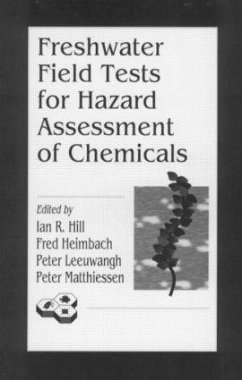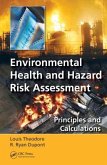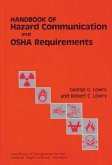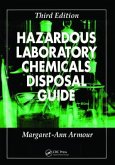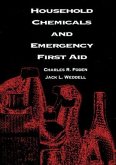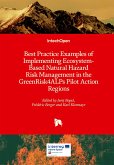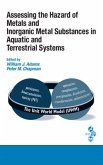Ian R. Hill, Fred Heimbach, Peter Leeuwangh
Freshwater Field Tests for Hazard Assessment of Chemicals
Ian R. Hill, Fred Heimbach, Peter Leeuwangh
Freshwater Field Tests for Hazard Assessment of Chemicals
- Gebundenes Buch
- Merkliste
- Auf die Merkliste
- Bewerten Bewerten
- Teilen
- Produkt teilen
- Produkterinnerung
- Produkterinnerung
Freshwater field tests are an integral part of the process of hazard assessment of pesticides and other chemicals in the environment. This book brings together international experts on microcosms and mesocosms for a critical appraisal of theory and practice on the subject of freshwater field tests for hazard assessment. It is an authoritative and comprehensive summary of knowledge about freshwater field tests, with particular emphasis on their optimization for scientific and regulatory purposes. This valuable reference covers both lotic and lentic outdoor systems and addresses the choice of…mehr
Andere Kunden interessierten sich auch für
![Environmental Health and Hazard Risk Assessment Environmental Health and Hazard Risk Assessment]() Louis TheodoreEnvironmental Health and Hazard Risk Assessment229,99 €
Louis TheodoreEnvironmental Health and Hazard Risk Assessment229,99 €![Handbook of Hazard Communication and OSHA Requirements Handbook of Hazard Communication and OSHA Requirements]() LowryHandbook of Hazard Communication and OSHA Requirements316,99 €
LowryHandbook of Hazard Communication and OSHA Requirements316,99 €![Hazardous Laboratory Chemicals Disposal Guide Hazardous Laboratory Chemicals Disposal Guide]() Margaret-Ann ArmourHazardous Laboratory Chemicals Disposal Guide365,99 €
Margaret-Ann ArmourHazardous Laboratory Chemicals Disposal Guide365,99 €![Household Chemicals and Emergency First Aid Household Chemicals and Emergency First Aid]() Betty A. FodenHousehold Chemicals and Emergency First Aid393,99 €
Betty A. FodenHousehold Chemicals and Emergency First Aid393,99 €![Best Practice Examples of Implementing Ecosystem-Based Natural Hazard Risk Management in the GreenRisk4ALPs Pilot Action Regions Best Practice Examples of Implementing Ecosystem-Based Natural Hazard Risk Management in the GreenRisk4ALPs Pilot Action Regions]() Best Practice Examples of Implementing Ecosystem-Based Natural Hazard Risk Management in the GreenRisk4ALPs Pilot Action Regions129,00 €
Best Practice Examples of Implementing Ecosystem-Based Natural Hazard Risk Management in the GreenRisk4ALPs Pilot Action Regions129,00 €![Polyfluorinated Chemicals and Transformation Products Polyfluorinated Chemicals and Transformation Products]() Polyfluorinated Chemicals and Transformation Products161,99 €
Polyfluorinated Chemicals and Transformation Products161,99 €![Assessing the Hazard of Metals and Inorganic Metal Substances in Aquatic and Terrestrial Systems Assessing the Hazard of Metals and Inorganic Metal Substances in Aquatic and Terrestrial Systems]() William J. Adams / Peter M. Chapman (eds.)Assessing the Hazard of Metals and Inorganic Metal Substances in Aquatic and Terrestrial Systems271,99 €
William J. Adams / Peter M. Chapman (eds.)Assessing the Hazard of Metals and Inorganic Metal Substances in Aquatic and Terrestrial Systems271,99 €-
-
-
Freshwater field tests are an integral part of the process of hazard assessment of pesticides and other chemicals in the environment. This book brings together international experts on microcosms and mesocosms for a critical appraisal of theory and practice on the subject of freshwater field tests for hazard assessment. It is an authoritative and comprehensive summary of knowledge about freshwater field tests, with particular emphasis on their optimization for scientific and regulatory purposes. This valuable reference covers both lotic and lentic outdoor systems and addresses the choice of endpoints and test methodology. Instructive case histories show how to extrapolate test results to the real world.
Hinweis: Dieser Artikel kann nur an eine deutsche Lieferadresse ausgeliefert werden.
Hinweis: Dieser Artikel kann nur an eine deutsche Lieferadresse ausgeliefert werden.
Produktdetails
- Produktdetails
- Verlag: CRC Press
- Seitenzahl: 600
- Erscheinungstermin: 5. April 1994
- Englisch
- Abmessung: 240mm x 161mm x 36mm
- Gewicht: 1057g
- ISBN-13: 9780873719407
- ISBN-10: 0873719409
- Artikelnr.: 21040398
- Herstellerkennzeichnung
- Libri GmbH
- Europaallee 1
- 36244 Bad Hersfeld
- gpsr@libri.de
- Verlag: CRC Press
- Seitenzahl: 600
- Erscheinungstermin: 5. April 1994
- Englisch
- Abmessung: 240mm x 161mm x 36mm
- Gewicht: 1057g
- ISBN-13: 9780873719407
- ISBN-10: 0873719409
- Artikelnr.: 21040398
- Herstellerkennzeichnung
- Libri GmbH
- Europaallee 1
- 36244 Bad Hersfeld
- gpsr@libri.de
Hill, Ian R.; Heimbach, Fred; Leeuwangh, Peter; Matthiessen, Peter
Endpoints in Aquatic Field Tests: The Concept of Ecological Stability
Applied to Aquatic Ecosystems (A. Seitz). On the Choice of Structural
Parameters and Endpoints to Indicate Responses of Freshwater Ecosystems to
Pesticide Stress (T.C.M. Brock and B.J. Budde). Functional Endpoints in
Field Testing (K. Kersting). Interpreting the Results of Agricultural
Microcosm Tests: Linking Laboratory and Experimental Field Results to
Predictions of Effect in Natural Ecosystems (T.W. La Point). Structural and
Taxonomic Types of Zooperiphyton as Criteria of Freshwater Field Testing
(I.A. Skalskaya). Methodologies of Aquatic Field Tests: Prediction of
Exposure Concentrations in Surface Waters (P. Groenendijk, J.W.H. van der
Kolk, and K.Z. Travis). System Design for Field Tests in Flowing Waters:
Design and Use of Outdoor Artificial Streams in Ecotoxicology (G.C.
Mitchell). Methodologies of Aquatic Field Tests: System Design for Field
Tests in Still Waters (F. Heimbach). Sampling and Analysis of the Test
Chemical in Microcosms and Mesocosms (J.M. Giddings). Sampling and Analysis
Strategy for Biological Effects in Freshwater Field Tests (J.H. Kennedy,
Z.B. Johnson, and P.C. Johnson). Are Aquatic Macrophytes Useful in Field
Tests? (G. Blake). Large-Scale Outdoor Microcosms: Tools for Ecological
Assessment of Pesticides (J.M. Giddings, R.L. Helm, and F.J. deNoyelles,
Jr.). Use of Limnocorrals for Assessing the Aquatic Fate and Effects of
Pesticides (K. Liber). Case Studies of Aquatic Field Tests: Comparison of
Chlorpyrifos Fate and Effects in Outdoor Aquatic Micro- and Mesocosms of
Various Scale and Construction (P. Leeuwangh). Review of Aquatic Field
Tests with Pyrethroid Insecticides (I.R. Hill, J.L. Shaw, and S.J. Maund).
Atrazine in Aquatic Test Systems: An Evaluation of Ecotoxicological Risks
(W. Huber). Review of Experimental Microcosm, Mesocosm, and Field Tests
Used to Evaluate the Potential Hazard of Surfactants to Aquatic Life and
the Relation to Single Species Data (S.E. Belanger). Fate of Chlorpyrifos
in Indoor Microcosms and Outdoor Experimental Ditches (S.J.H. Crum and
T.C.M. Brock). Response of Aquatic Outdoor Microcosms of the "Split-Pond"
Type to Chemical Contamination (R. Draxl, K.E. Neugebaur-Buchler, F.-J.
Zieris, and W. Huber). The Effects of Lambda-Cyhalothrin in Aquatic Field
Studies (M.J. Hamer, I.R. Hill, L. Rondon, and A. Caguan). Comparison of
the Effects of a Herbicide (Metamitron) in Outdoor Pond "Microcosms" and in
Standardized Laboratory Tests (F. Heimbach). Effects of Lambda-Cyhalothrin
on Aquatic Organisms in Large-Scale Mesocosms (I.R. Hill, J.K. Runnalls,
J.H. Kennedy, and P. Ekoniak). Aquatic Testing of Trichlorphon in the
Laboratory and Field (Z. Svobodova and R. Faina). The Role of Periphyton in
Primary Production in Outdoor Microcosms Treated with 3,4-dichloroaniline
(DCA) (A. Thielcke and H.-T. Ratte). Extrapolation and Hazard Assessment:
Field Validation of Predictions Based on Laboratory Toxicity Tests (G.
Persoone and C.R. Janssen). Modelling of Aquatic Field Tests for Hazard
Assessment (H.-T. Ratte, H.J. Poethke, U. Dulmer, and U. Hommen). The Role
of Field Tests in Hazard Assessment of Chemicals (K. van Leeuwen, H.-J.
Emans, E. Van De Plassche, and H. Canton). Hazard Assessment from Field
Tests in the U.K.: Pond Mesocosms and Microcosms-The Need for a Flexible
Approach to Experiment Design (R.R. Stephenson). Hazard Assessment from
Field Tests in Germany (H. Kopp). Guidelines for Pesticide Hazard
Assessment with Freshwater Field Tests at the International Level (P.
Matthiessen). Models for Hazard Assessment-Problems and Perspectives (H.J.
Poethke, D. Oertel, and A. Seitz). Modelling and Other Issues: The
"Dreissena-Monitor"-Improved Evaluation of Dynamic Limits for the
Establishment of Alarm-Thresholds During Toxicity Tests and for Continuous
Water Control (J. Borcherding). A Proposed Test Method for the Assessment
of Pesticide Impact on Sediment Dwelling Larvae of the Midge Chironomus
riparius (G.P. Dohmen and K.L. Barrett). Application of a Plankton
Simulation Model to Outdoor-Microcosm Case Studies (U. Hommen and H.-T.
Ratte). A Computer Program to Evaluate Plankton Data from Freshwater Field
Tests (U. Hommen, D. Veith, and U. Dulmer). pH as a Functional Endpoint of
Chemical Hazard Assessment in Aquatic Outdoor Microcosms (K.E.
Neugebaur-Buchler, R. Draxl, F.-J. Zieris, and W. Huber). What Is Known on
Natural Limiting Factors for Macrozoobenthos Species in Freshwaters? (D.
Neumann, M. Volpers, I. Raschke, U. Grauel, and F. Cichos). The pT-Value as
an Indicator of Toxicity in the Aquatic Environment (W. Sloof and D. de
Zwart). Modelling Studies of the Applicability of Micro- and Mesocosm
Approaches for Ecotoxicological Investigations (P.P. Umorin). Index.
Applied to Aquatic Ecosystems (A. Seitz). On the Choice of Structural
Parameters and Endpoints to Indicate Responses of Freshwater Ecosystems to
Pesticide Stress (T.C.M. Brock and B.J. Budde). Functional Endpoints in
Field Testing (K. Kersting). Interpreting the Results of Agricultural
Microcosm Tests: Linking Laboratory and Experimental Field Results to
Predictions of Effect in Natural Ecosystems (T.W. La Point). Structural and
Taxonomic Types of Zooperiphyton as Criteria of Freshwater Field Testing
(I.A. Skalskaya). Methodologies of Aquatic Field Tests: Prediction of
Exposure Concentrations in Surface Waters (P. Groenendijk, J.W.H. van der
Kolk, and K.Z. Travis). System Design for Field Tests in Flowing Waters:
Design and Use of Outdoor Artificial Streams in Ecotoxicology (G.C.
Mitchell). Methodologies of Aquatic Field Tests: System Design for Field
Tests in Still Waters (F. Heimbach). Sampling and Analysis of the Test
Chemical in Microcosms and Mesocosms (J.M. Giddings). Sampling and Analysis
Strategy for Biological Effects in Freshwater Field Tests (J.H. Kennedy,
Z.B. Johnson, and P.C. Johnson). Are Aquatic Macrophytes Useful in Field
Tests? (G. Blake). Large-Scale Outdoor Microcosms: Tools for Ecological
Assessment of Pesticides (J.M. Giddings, R.L. Helm, and F.J. deNoyelles,
Jr.). Use of Limnocorrals for Assessing the Aquatic Fate and Effects of
Pesticides (K. Liber). Case Studies of Aquatic Field Tests: Comparison of
Chlorpyrifos Fate and Effects in Outdoor Aquatic Micro- and Mesocosms of
Various Scale and Construction (P. Leeuwangh). Review of Aquatic Field
Tests with Pyrethroid Insecticides (I.R. Hill, J.L. Shaw, and S.J. Maund).
Atrazine in Aquatic Test Systems: An Evaluation of Ecotoxicological Risks
(W. Huber). Review of Experimental Microcosm, Mesocosm, and Field Tests
Used to Evaluate the Potential Hazard of Surfactants to Aquatic Life and
the Relation to Single Species Data (S.E. Belanger). Fate of Chlorpyrifos
in Indoor Microcosms and Outdoor Experimental Ditches (S.J.H. Crum and
T.C.M. Brock). Response of Aquatic Outdoor Microcosms of the "Split-Pond"
Type to Chemical Contamination (R. Draxl, K.E. Neugebaur-Buchler, F.-J.
Zieris, and W. Huber). The Effects of Lambda-Cyhalothrin in Aquatic Field
Studies (M.J. Hamer, I.R. Hill, L. Rondon, and A. Caguan). Comparison of
the Effects of a Herbicide (Metamitron) in Outdoor Pond "Microcosms" and in
Standardized Laboratory Tests (F. Heimbach). Effects of Lambda-Cyhalothrin
on Aquatic Organisms in Large-Scale Mesocosms (I.R. Hill, J.K. Runnalls,
J.H. Kennedy, and P. Ekoniak). Aquatic Testing of Trichlorphon in the
Laboratory and Field (Z. Svobodova and R. Faina). The Role of Periphyton in
Primary Production in Outdoor Microcosms Treated with 3,4-dichloroaniline
(DCA) (A. Thielcke and H.-T. Ratte). Extrapolation and Hazard Assessment:
Field Validation of Predictions Based on Laboratory Toxicity Tests (G.
Persoone and C.R. Janssen). Modelling of Aquatic Field Tests for Hazard
Assessment (H.-T. Ratte, H.J. Poethke, U. Dulmer, and U. Hommen). The Role
of Field Tests in Hazard Assessment of Chemicals (K. van Leeuwen, H.-J.
Emans, E. Van De Plassche, and H. Canton). Hazard Assessment from Field
Tests in the U.K.: Pond Mesocosms and Microcosms-The Need for a Flexible
Approach to Experiment Design (R.R. Stephenson). Hazard Assessment from
Field Tests in Germany (H. Kopp). Guidelines for Pesticide Hazard
Assessment with Freshwater Field Tests at the International Level (P.
Matthiessen). Models for Hazard Assessment-Problems and Perspectives (H.J.
Poethke, D. Oertel, and A. Seitz). Modelling and Other Issues: The
"Dreissena-Monitor"-Improved Evaluation of Dynamic Limits for the
Establishment of Alarm-Thresholds During Toxicity Tests and for Continuous
Water Control (J. Borcherding). A Proposed Test Method for the Assessment
of Pesticide Impact on Sediment Dwelling Larvae of the Midge Chironomus
riparius (G.P. Dohmen and K.L. Barrett). Application of a Plankton
Simulation Model to Outdoor-Microcosm Case Studies (U. Hommen and H.-T.
Ratte). A Computer Program to Evaluate Plankton Data from Freshwater Field
Tests (U. Hommen, D. Veith, and U. Dulmer). pH as a Functional Endpoint of
Chemical Hazard Assessment in Aquatic Outdoor Microcosms (K.E.
Neugebaur-Buchler, R. Draxl, F.-J. Zieris, and W. Huber). What Is Known on
Natural Limiting Factors for Macrozoobenthos Species in Freshwaters? (D.
Neumann, M. Volpers, I. Raschke, U. Grauel, and F. Cichos). The pT-Value as
an Indicator of Toxicity in the Aquatic Environment (W. Sloof and D. de
Zwart). Modelling Studies of the Applicability of Micro- and Mesocosm
Approaches for Ecotoxicological Investigations (P.P. Umorin). Index.
Endpoints in Aquatic Field Tests: The Concept of Ecological Stability
Applied to Aquatic Ecosystems (A. Seitz). On the Choice of Structural
Parameters and Endpoints to Indicate Responses of Freshwater Ecosystems to
Pesticide Stress (T.C.M. Brock and B.J. Budde). Functional Endpoints in
Field Testing (K. Kersting). Interpreting the Results of Agricultural
Microcosm Tests: Linking Laboratory and Experimental Field Results to
Predictions of Effect in Natural Ecosystems (T.W. La Point). Structural and
Taxonomic Types of Zooperiphyton as Criteria of Freshwater Field Testing
(I.A. Skalskaya). Methodologies of Aquatic Field Tests: Prediction of
Exposure Concentrations in Surface Waters (P. Groenendijk, J.W.H. van der
Kolk, and K.Z. Travis). System Design for Field Tests in Flowing Waters:
Design and Use of Outdoor Artificial Streams in Ecotoxicology (G.C.
Mitchell). Methodologies of Aquatic Field Tests: System Design for Field
Tests in Still Waters (F. Heimbach). Sampling and Analysis of the Test
Chemical in Microcosms and Mesocosms (J.M. Giddings). Sampling and Analysis
Strategy for Biological Effects in Freshwater Field Tests (J.H. Kennedy,
Z.B. Johnson, and P.C. Johnson). Are Aquatic Macrophytes Useful in Field
Tests? (G. Blake). Large-Scale Outdoor Microcosms: Tools for Ecological
Assessment of Pesticides (J.M. Giddings, R.L. Helm, and F.J. deNoyelles,
Jr.). Use of Limnocorrals for Assessing the Aquatic Fate and Effects of
Pesticides (K. Liber). Case Studies of Aquatic Field Tests: Comparison of
Chlorpyrifos Fate and Effects in Outdoor Aquatic Micro- and Mesocosms of
Various Scale and Construction (P. Leeuwangh). Review of Aquatic Field
Tests with Pyrethroid Insecticides (I.R. Hill, J.L. Shaw, and S.J. Maund).
Atrazine in Aquatic Test Systems: An Evaluation of Ecotoxicological Risks
(W. Huber). Review of Experimental Microcosm, Mesocosm, and Field Tests
Used to Evaluate the Potential Hazard of Surfactants to Aquatic Life and
the Relation to Single Species Data (S.E. Belanger). Fate of Chlorpyrifos
in Indoor Microcosms and Outdoor Experimental Ditches (S.J.H. Crum and
T.C.M. Brock). Response of Aquatic Outdoor Microcosms of the "Split-Pond"
Type to Chemical Contamination (R. Draxl, K.E. Neugebaur-Buchler, F.-J.
Zieris, and W. Huber). The Effects of Lambda-Cyhalothrin in Aquatic Field
Studies (M.J. Hamer, I.R. Hill, L. Rondon, and A. Caguan). Comparison of
the Effects of a Herbicide (Metamitron) in Outdoor Pond "Microcosms" and in
Standardized Laboratory Tests (F. Heimbach). Effects of Lambda-Cyhalothrin
on Aquatic Organisms in Large-Scale Mesocosms (I.R. Hill, J.K. Runnalls,
J.H. Kennedy, and P. Ekoniak). Aquatic Testing of Trichlorphon in the
Laboratory and Field (Z. Svobodova and R. Faina). The Role of Periphyton in
Primary Production in Outdoor Microcosms Treated with 3,4-dichloroaniline
(DCA) (A. Thielcke and H.-T. Ratte). Extrapolation and Hazard Assessment:
Field Validation of Predictions Based on Laboratory Toxicity Tests (G.
Persoone and C.R. Janssen). Modelling of Aquatic Field Tests for Hazard
Assessment (H.-T. Ratte, H.J. Poethke, U. Dulmer, and U. Hommen). The Role
of Field Tests in Hazard Assessment of Chemicals (K. van Leeuwen, H.-J.
Emans, E. Van De Plassche, and H. Canton). Hazard Assessment from Field
Tests in the U.K.: Pond Mesocosms and Microcosms-The Need for a Flexible
Approach to Experiment Design (R.R. Stephenson). Hazard Assessment from
Field Tests in Germany (H. Kopp). Guidelines for Pesticide Hazard
Assessment with Freshwater Field Tests at the International Level (P.
Matthiessen). Models for Hazard Assessment-Problems and Perspectives (H.J.
Poethke, D. Oertel, and A. Seitz). Modelling and Other Issues: The
"Dreissena-Monitor"-Improved Evaluation of Dynamic Limits for the
Establishment of Alarm-Thresholds During Toxicity Tests and for Continuous
Water Control (J. Borcherding). A Proposed Test Method for the Assessment
of Pesticide Impact on Sediment Dwelling Larvae of the Midge Chironomus
riparius (G.P. Dohmen and K.L. Barrett). Application of a Plankton
Simulation Model to Outdoor-Microcosm Case Studies (U. Hommen and H.-T.
Ratte). A Computer Program to Evaluate Plankton Data from Freshwater Field
Tests (U. Hommen, D. Veith, and U. Dulmer). pH as a Functional Endpoint of
Chemical Hazard Assessment in Aquatic Outdoor Microcosms (K.E.
Neugebaur-Buchler, R. Draxl, F.-J. Zieris, and W. Huber). What Is Known on
Natural Limiting Factors for Macrozoobenthos Species in Freshwaters? (D.
Neumann, M. Volpers, I. Raschke, U. Grauel, and F. Cichos). The pT-Value as
an Indicator of Toxicity in the Aquatic Environment (W. Sloof and D. de
Zwart). Modelling Studies of the Applicability of Micro- and Mesocosm
Approaches for Ecotoxicological Investigations (P.P. Umorin). Index.
Applied to Aquatic Ecosystems (A. Seitz). On the Choice of Structural
Parameters and Endpoints to Indicate Responses of Freshwater Ecosystems to
Pesticide Stress (T.C.M. Brock and B.J. Budde). Functional Endpoints in
Field Testing (K. Kersting). Interpreting the Results of Agricultural
Microcosm Tests: Linking Laboratory and Experimental Field Results to
Predictions of Effect in Natural Ecosystems (T.W. La Point). Structural and
Taxonomic Types of Zooperiphyton as Criteria of Freshwater Field Testing
(I.A. Skalskaya). Methodologies of Aquatic Field Tests: Prediction of
Exposure Concentrations in Surface Waters (P. Groenendijk, J.W.H. van der
Kolk, and K.Z. Travis). System Design for Field Tests in Flowing Waters:
Design and Use of Outdoor Artificial Streams in Ecotoxicology (G.C.
Mitchell). Methodologies of Aquatic Field Tests: System Design for Field
Tests in Still Waters (F. Heimbach). Sampling and Analysis of the Test
Chemical in Microcosms and Mesocosms (J.M. Giddings). Sampling and Analysis
Strategy for Biological Effects in Freshwater Field Tests (J.H. Kennedy,
Z.B. Johnson, and P.C. Johnson). Are Aquatic Macrophytes Useful in Field
Tests? (G. Blake). Large-Scale Outdoor Microcosms: Tools for Ecological
Assessment of Pesticides (J.M. Giddings, R.L. Helm, and F.J. deNoyelles,
Jr.). Use of Limnocorrals for Assessing the Aquatic Fate and Effects of
Pesticides (K. Liber). Case Studies of Aquatic Field Tests: Comparison of
Chlorpyrifos Fate and Effects in Outdoor Aquatic Micro- and Mesocosms of
Various Scale and Construction (P. Leeuwangh). Review of Aquatic Field
Tests with Pyrethroid Insecticides (I.R. Hill, J.L. Shaw, and S.J. Maund).
Atrazine in Aquatic Test Systems: An Evaluation of Ecotoxicological Risks
(W. Huber). Review of Experimental Microcosm, Mesocosm, and Field Tests
Used to Evaluate the Potential Hazard of Surfactants to Aquatic Life and
the Relation to Single Species Data (S.E. Belanger). Fate of Chlorpyrifos
in Indoor Microcosms and Outdoor Experimental Ditches (S.J.H. Crum and
T.C.M. Brock). Response of Aquatic Outdoor Microcosms of the "Split-Pond"
Type to Chemical Contamination (R. Draxl, K.E. Neugebaur-Buchler, F.-J.
Zieris, and W. Huber). The Effects of Lambda-Cyhalothrin in Aquatic Field
Studies (M.J. Hamer, I.R. Hill, L. Rondon, and A. Caguan). Comparison of
the Effects of a Herbicide (Metamitron) in Outdoor Pond "Microcosms" and in
Standardized Laboratory Tests (F. Heimbach). Effects of Lambda-Cyhalothrin
on Aquatic Organisms in Large-Scale Mesocosms (I.R. Hill, J.K. Runnalls,
J.H. Kennedy, and P. Ekoniak). Aquatic Testing of Trichlorphon in the
Laboratory and Field (Z. Svobodova and R. Faina). The Role of Periphyton in
Primary Production in Outdoor Microcosms Treated with 3,4-dichloroaniline
(DCA) (A. Thielcke and H.-T. Ratte). Extrapolation and Hazard Assessment:
Field Validation of Predictions Based on Laboratory Toxicity Tests (G.
Persoone and C.R. Janssen). Modelling of Aquatic Field Tests for Hazard
Assessment (H.-T. Ratte, H.J. Poethke, U. Dulmer, and U. Hommen). The Role
of Field Tests in Hazard Assessment of Chemicals (K. van Leeuwen, H.-J.
Emans, E. Van De Plassche, and H. Canton). Hazard Assessment from Field
Tests in the U.K.: Pond Mesocosms and Microcosms-The Need for a Flexible
Approach to Experiment Design (R.R. Stephenson). Hazard Assessment from
Field Tests in Germany (H. Kopp). Guidelines for Pesticide Hazard
Assessment with Freshwater Field Tests at the International Level (P.
Matthiessen). Models for Hazard Assessment-Problems and Perspectives (H.J.
Poethke, D. Oertel, and A. Seitz). Modelling and Other Issues: The
"Dreissena-Monitor"-Improved Evaluation of Dynamic Limits for the
Establishment of Alarm-Thresholds During Toxicity Tests and for Continuous
Water Control (J. Borcherding). A Proposed Test Method for the Assessment
of Pesticide Impact on Sediment Dwelling Larvae of the Midge Chironomus
riparius (G.P. Dohmen and K.L. Barrett). Application of a Plankton
Simulation Model to Outdoor-Microcosm Case Studies (U. Hommen and H.-T.
Ratte). A Computer Program to Evaluate Plankton Data from Freshwater Field
Tests (U. Hommen, D. Veith, and U. Dulmer). pH as a Functional Endpoint of
Chemical Hazard Assessment in Aquatic Outdoor Microcosms (K.E.
Neugebaur-Buchler, R. Draxl, F.-J. Zieris, and W. Huber). What Is Known on
Natural Limiting Factors for Macrozoobenthos Species in Freshwaters? (D.
Neumann, M. Volpers, I. Raschke, U. Grauel, and F. Cichos). The pT-Value as
an Indicator of Toxicity in the Aquatic Environment (W. Sloof and D. de
Zwart). Modelling Studies of the Applicability of Micro- and Mesocosm
Approaches for Ecotoxicological Investigations (P.P. Umorin). Index.

